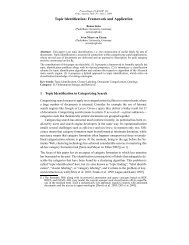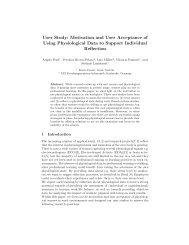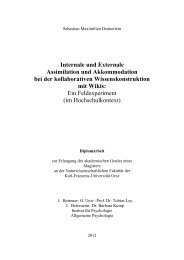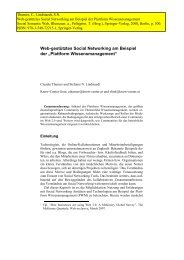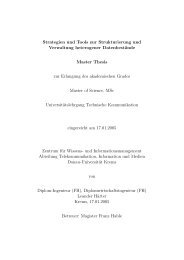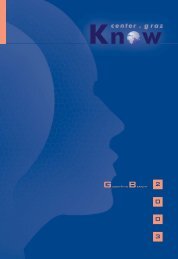Fostering adoption, acceptance and assimilation in ... - KnowMiner
Fostering adoption, acceptance and assimilation in ... - KnowMiner
Fostering adoption, acceptance and assimilation in ... - KnowMiner
Create successful ePaper yourself
Turn your PDF publications into a flip-book with our unique Google optimized e-Paper software.
In consideration of the fact that <strong>assimilation</strong> as a third step refers<br />
to the diffusion of a solution <strong>in</strong>to organizational processes <strong>and</strong><br />
work practices, nearly all of the factors correspond to<br />
organization-specific peculiarities. However, when look<strong>in</strong>g at the<br />
factors that are highly affected by a new KMS, we expect Process<br />
Characteristics <strong>and</strong> Social System Characteristics to change<br />
depend<strong>in</strong>g on the design of the <strong>in</strong>troduced KMS. Consequently,<br />
the factors with<strong>in</strong> these two groups can be <strong>in</strong>directly <strong>in</strong>fluenced by<br />
design decisions. In contrast, the <strong>in</strong>troduction of a KMS will<br />
probably have less impact on Management Characteristics or<br />
Institutional Characteristics.<br />
Table 3: List of Factors for Process Assimilation<br />
Factor name Model/Theory<br />
Communication Channels Use DOI<br />
Decision-mak<strong>in</strong>g Patterns DOI<br />
Extent of Coord<strong>in</strong>ation INST<br />
Functional Integration DOI<br />
Knowledge Barrier DOI<br />
Knowledge Embeddedness DOI<br />
Management Championship INST<br />
Methodology Influence INST<br />
Organizational Size KBT<br />
IT Function Size DOI; INST<br />
Process Cost BPM<br />
Process Quality BPM<br />
Process Time BPM<br />
Process Satisfaction BPM<br />
Promotion of Collaboration DOI<br />
Quality of Senior Leadership KBT<br />
Sophistication of IT Infrastructures KBT<br />
Strategic Investment Rationale INST<br />
Structures of Significance ST; INST (cognitive)<br />
Structures of Dom<strong>in</strong>ation ST; INST (regulatory)<br />
Structures of Legitimation ST; INST (normative)<br />
Top Management Championship ST<br />
3.4 Result<strong>in</strong>g Model<br />
Figure 1 presents the comprehensive model that comb<strong>in</strong>es factors<br />
impact<strong>in</strong>g on the process of <strong>adoption</strong>, <strong>acceptance</strong> <strong>and</strong> <strong>assimilation</strong><br />
of KMS. Moreover, the factors have been categorized so that<br />
guidance can be offered on two levels of granularity, namely the<br />
level of groups of factors <strong>and</strong> the level of <strong>in</strong>dividual factors.<br />
Furthermore, the model visually separates the groups that can be<br />
<strong>in</strong>fluenced with<strong>in</strong> the design phase from groups that cannot be<br />
<strong>in</strong>fluenced as argued above.<br />
This differentiation seems useful because designers of KMS can<br />
dist<strong>in</strong>guish between factors that can be <strong>in</strong>fluenced <strong>and</strong> thus are<br />
important when elicit<strong>in</strong>g functional <strong>and</strong> non-functional<br />
requirements while others can be considered as environmental<br />
limitations which need to be taken <strong>in</strong>to account particularly when<br />
packag<strong>in</strong>g a KMS <strong>and</strong> offer<strong>in</strong>g it to various target groups. The set<br />
of groups that cannot be <strong>in</strong>fluenced by design partially consists of<br />
environmental characteristics which cannot be directly<br />
manipulated, neither by providers of KMS nor by organizations<br />
us<strong>in</strong>g them. Other factors that cannot be <strong>in</strong>fluenced correspond to<br />
characteristics of an organization <strong>and</strong> <strong>in</strong>dividuals will<strong>in</strong>g to adopt<br />
a new technology that are comparably stable over time. However,<br />
some factors <strong>in</strong> this set of groups can be changed when us<strong>in</strong>g a<br />
KMS. Examples are Social Systems Characteristics which are<br />
<strong>in</strong>fluenced by IT <strong>and</strong> also <strong>in</strong>fluence how IT is used. Accord<strong>in</strong>g to<br />
AST, designers should particularly be aware of these<br />
characteristics <strong>and</strong> should explicitly state the <strong>in</strong>tended use of the<br />
KMS which, however, needs to be dist<strong>in</strong>guished from the KMS’s<br />
actual use <strong>in</strong> a particular organization.<br />
4. RELATED WORK & APPLICATION<br />
Thus far, we have presented a comprehensive model of factors<br />
relevant for KMS design impact<strong>in</strong>g the <strong>adoption</strong>, <strong>acceptance</strong>, <strong>and</strong><br />
<strong>assimilation</strong> of IT. The model <strong>in</strong>tends to provide guidance for<br />
analyz<strong>in</strong>g <strong>and</strong> reflect<strong>in</strong>g decisions related to KMS design,<br />
development <strong>and</strong> implementation <strong>in</strong> organizations based on the<br />
collected factor groups <strong>and</strong> their factors for each phase <strong>in</strong> the<br />
context of an ongo<strong>in</strong>g software project. This manner of <strong>in</strong>form<strong>in</strong>g<br />
software design, compris<strong>in</strong>g for example phases such as<br />
requirements elicitation, configuration, packag<strong>in</strong>g, <strong>and</strong> offer<strong>in</strong>g, is<br />
not yet widely observable <strong>in</strong> the doma<strong>in</strong> of KM. However, some<br />
comparable work <strong>in</strong> the general doma<strong>in</strong> of IS research can be<br />
named.<br />
In ongo<strong>in</strong>g research, an evaluation model for Question Answer<strong>in</strong>g<br />
Systems has been developed that focuses on user-centered<br />
evaluation rather than on system-centered evaluation. The<br />
proposed model comprises constructs taken from behavioral<br />
science models, such as TAM, UTAUT, TRA, <strong>and</strong> TPB, to<br />
<strong>in</strong>crease user <strong>acceptance</strong> when design<strong>in</strong>g Question Answer<strong>in</strong>g<br />
Systems [39,40]. Another study focuses on Employee<br />
Relationship Management systems <strong>and</strong> <strong>in</strong>vestigates the impact of<br />
usefulness on systems quality perceptions. Specific user needs<br />
should be considered <strong>in</strong> the analysis phase of system design <strong>and</strong><br />
therefore need to be assessed properly. The model draws upon<br />
TAM among others to expla<strong>in</strong> perceived usefulness [41]. It is<br />
rather common to use research results amalgamated <strong>in</strong>to a s<strong>in</strong>gle<br />
model for predict<strong>in</strong>g behavior to <strong>in</strong>form system design. For<br />
example, a study used TAM to measure perceived usefulness<br />
when analyz<strong>in</strong>g the connection between website design <strong>and</strong><br />
impulse buy<strong>in</strong>g <strong>in</strong> the doma<strong>in</strong> of e-commerce. Subsequently,<br />
research results were used to give concrete recommendations for<br />
e-commerce website designers [42].<br />
In the application of our model we followed a similar approach. In<br />
context of a large-scale research <strong>and</strong> development project, we<br />
applied the proposed model for <strong>in</strong>form<strong>in</strong>g <strong>and</strong> extend<strong>in</strong>g<br />
requirements elicitation (especially for non-functional<br />
requirements), as well as support<strong>in</strong>g decisions with respect to<br />
packag<strong>in</strong>g <strong>and</strong> offer<strong>in</strong>g of the KMS implemented <strong>in</strong> this project.<br />
The project aims at design<strong>in</strong>g an ICT solution support<strong>in</strong>g <strong>and</strong><br />
enhanc<strong>in</strong>g employees <strong>in</strong> their daily activities related to Human<br />
Resource Management, Bus<strong>in</strong>ess Process Management, KM <strong>and</strong><br />
Innovation Management. In our efforts to <strong>in</strong>crease <strong>adoption</strong>,<br />
<strong>acceptance</strong>, <strong>and</strong> <strong>assimilation</strong> of this KMS, 77 recommendations<br />
were developed for the design of the platform <strong>and</strong> addressed to<br />
platform architects, designers <strong>and</strong> developers of related bus<strong>in</strong>ess<br />
plans. These recommendations were developed by evaluat<strong>in</strong>g so<br />
far def<strong>in</strong>ed requirements, technological trends, <strong>and</strong> the ICT<br />
l<strong>and</strong>scapes of pilot organizations <strong>in</strong> respect to our model.<br />
The rema<strong>in</strong>der of this section will exemplify the use of the<br />
presented model to describe a collection of additional<br />
requirements <strong>and</strong> recommendations <strong>in</strong> two application areas.<br />
Here, application areas describe project-specific work groups that<br />
work on requirements elicitation, packag<strong>in</strong>g <strong>and</strong> offer<strong>in</strong>g solutions<br />
for the KMS.




